|
John Tyman's Cultures in Context Series EGYPT and the SAHARA www.johntyman.com/sahara |
|
3.1 Religion of the Pharaohs - Part I: 127-145 |
| . |
|
John Tyman's Cultures in Context Series EGYPT and the SAHARA www.johntyman.com/sahara |
|
3.1 Religion of the Pharaohs - Part I: 127-145 |
| . |
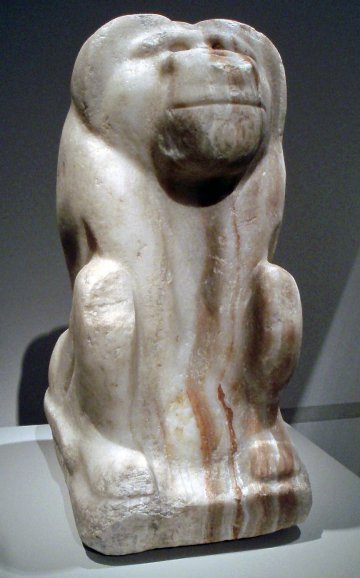 |
| .127. The original inhabitants of the Sahara would have been animists. In common with indigenous societies worldwide, who also depended on their environment for survival, people here lived in awe and/or fear of nature. Each tribe had its own God -- an animal or a tree perhaps -- and they continued this devotion after their move to the Nile valley. The different communities that dotted the river’s banks worshipped different gods at different (and rival) shrines. (Alabaster statue of a baboon god from about 3000BCE: courtesy Keith Schengli-Roberts at Wikipedia) |
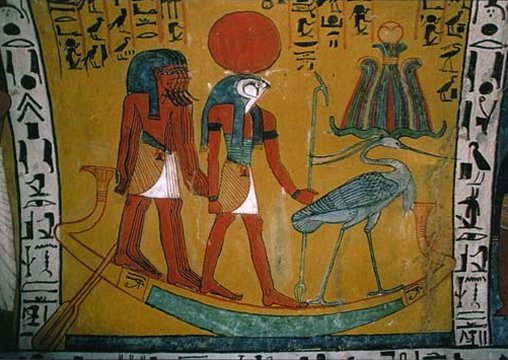 |
| .129. In addition, over time, each god also acquired a wife (or husband), a child, and/or a new identity. As a result it is impossible to establish a precise hierarchy of deities, though most cosmographies place Ra (or Re) at the top (otherwise known as Aten). Ammon (or Amun) began life as the local god of Thebes, but later became god of both war and fertility, and eventually absorbed the attributes of the sun god to become Amon-Re. He is portrayed with a head surmounted by a sun disk, riding in a golden ship across the sky during the day and through the underworld at night. Mythencyclopedia.com |
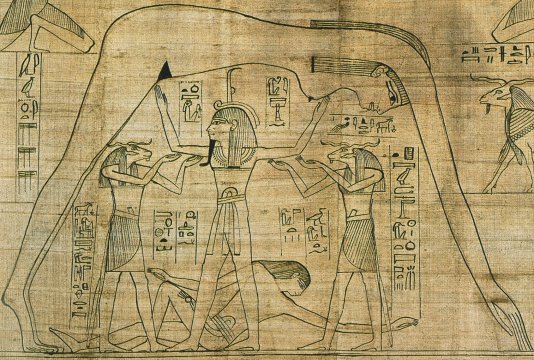 |
| .130. Nut, goddess of the sky, swallowed the sun each evening and gave birth to it each morning. She was the mother of Osiris who, because he was miraculously restored following his murder, symbolized eternal life. In this drawing Nut supports the sky with the help of Shu (god of wind and air) assisted by two lesser deities, while the earth god Seth reclines beneath them. (From the Greenfield Papyrus Book of the Dead, courtesy the British Museum at Wikipedia ) |
 |
| .131. Isis was the goddess of love, magic and motherhood. Her headdress is a throne (“isis” means “throne”) and as the personification of the throne she was an important representative of the pharaoh’s power.(Painting from the tomb of Seti I in the Valley of the Kings, at Wikipedia) |
 |
| .132. Isis is also honored as the protector of her brother Osiris (to whom she was married) and as the mother of Horus, god of the sky and war (whose emblem was the falcon). In this painting, from the tomb of Horemheb in the Valley of the Kings, Osiris is seated. Anubis stands between her and Horus. (Courtesy A. Parrot at Media.Tumblr.com) |
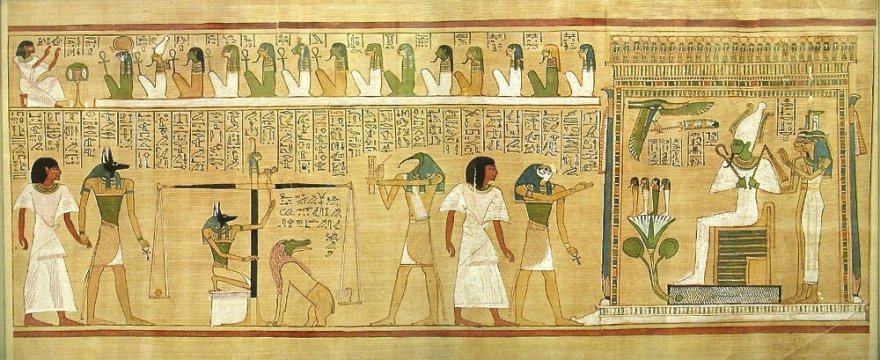 |
| .133. But there were many other gods symbolized by creatures from the animal world ...the lion, ibis, goat, cobra, crocodile, cow, hyena, scorpion, and vulture; plus the black jackal no one could escape -- symbol of Anubis god of judgment and patron of embalmers. Here he compares the heart of the scribe Hunefer with the weight of a feather. On the right, Thoth, scribe of the gods (with the head of an ibis) records the result. If the heart is lighter than the feather, Hunefer will be allowed to enjoy the pleasures of the after-life -- banquets, music, hunting and fishing. Otherwise he will be eaten by Ammit the Devourer, who has the mouth of a crocodile and the body of a lion and a hippo. In the next panel, showing the scene after the weighing, a triumphant Hunefer, having passed the test, is presented by falcon-headed Horus to the shrine of the green-skinned Osiris, god of the underworld and the dead, accompanied by Isis and Nephthys. The 14 gods of Egypt are shown seated above, in the role of judges. (Courtesy the British Museum at Wikipedia) |
 |
| .139. The pylon at Edfu is decorated with colossal reliefs showing Ptolemy XII offering captives in sacrifice to the gods Horus and Hathor. |
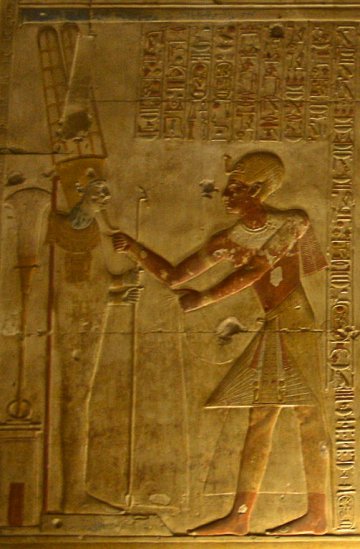 |
| 145. Rites were performed several times a day, and involved bathing, anointing, clothing and decorating the god’s image, followed by the offering of bread, meat, fruit and drink ... which were later consumed by the attendants. The god was then undressed, purified, and anointed. The priest would close the doors of the tabernacle, set his seal upon it, and withdraw backwards. Here the father of Ramses II, pharaoh Seti I, in his temple at Abydos, performs rituals before the god Amun whose crown is made of feathers. (Wikipedia) |
![]()
Text and photos by John Tyman
unless otherwise indicated.
Intended for Educational Use
Only.
Contact Dr. John Tyman at johntyman2@gmail.com
for more information regarding
licensing.
![]()
www.hillmanweb.com
Photo processing, Web page layout,
formatting and hosting by
William
Hillman ~ Brandon, Manitoba ~ Canada